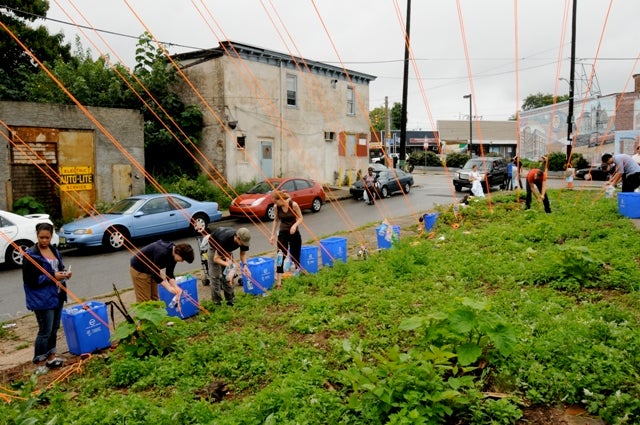Open to new ideas in Mantua

Aug. 24
By Anthony Campisi
For PlanPhilly
Not all empty lots need to be ugly.
At least, that was the message a group of architects and community activists were sending at an empty lot in West Philadelphia on Saturday.
The spot, on 40th Street just north of Lancaster Avenue, is to be the location of a new affordable-housing development. Dubbed Jannie’s Place after Councilwoman Jannie Blackwell, whose district includes the site, the project will provide 29 units for women and their families and will replace an empty lot that used to be the site of an auto repair shop.
On Saturday, though, the People’s Emergency Center (http://www.pec-cares.org/), which is building the units, turned the lot over to the Slought Foundation (http://slought.org/), the Community Design Collaborative (http://cdesignc.org/) and the National Constitution Center (http://constitutioncenter.org/ncc_home_Landing.aspx) to construct a public-art display.
Workers laid out a web of 40 orange laundry lines from the roof of an adjacent, abandoned, row home. Securing the lines into the ground with stakes, they then tied plastic bottles to the ropes, making a canopy to cover part of the site. The laundry lines were meant to evoke dense city living, according to architect Srdjan Weiss, who helped design the project.
Though the art installation was only in place for a day — work started at 8 that morning, and the lines were to be taken down that night — the idea was to draw the neighborhood’s attention to the space so that residents realized that “something could be here,” said Beth Miller, executive director of the CDC.
In addition to the project, the organizers also held a small workshop about how affordable housing functions. The project is part of a larger international exhibition began last year that is being hosted by the Slought Foundation, which is holding an exhibit at its location in West Philadelphia, as well as at the National Constitution Center.
The project, titled Into the Open (http://slought.org/content/11426/), examines the way architects and the built environment can foster civic engagement. Along that vein, Miller hoped that the display would attract residents as they walked and drove by, giving her and other members of the construction team a chance to explain the art installation and the new housing development.
The day got off to a slow, rainy start, and the construction team was worried that, if heavy rain came, the plastic bottles could fill up with water and put pressure on the rowhome. But by late morning the clouds had parted and people were milling around the edges of the lot, looking on curiously.
Theodore Liles, who lives on the 3900 block of Wallace Street in a house near the lot, praised the project. “Any development in there is good for us,” he said. And as the bottles began going up, more people stopped to ask questions and pitch in.
Lee Morris, who lives a few blocks away, first passed by with her 6-year-old son, Mark, on her way to the laundry. On the way back, she let him join the effort by tying plastic water bottles to the ropes. The bottles had holes punched in them, and he carefully threaded plastic ties through the holes and around the clothesline.
“He has a lot of energy,” Morris said before calling up her other children on her cell phone and having them come down.
Gloria Guard, president of the People’s Emergency Center, was also happy that the event offered free recycling bins provided by the Streets Department, giving residents a reason for coming to see the exhibit. Otherwise, “we’re a bunch of white people doing wacky stuff,” she explained, adding that she wanted to talk to as many people who walked and drove by to draw them into a discussion about the space and about recycling.
Ericka Brunsen was one such woman. She lived in a shelter run by the PEC, which also helped her find a union job and move into her own house. She was impressed by the project because of the dearth of parks in the neighborhood. Though there are many open lots, few are maintained and the only city park is near the Penn Presbyterian Medical Center.
Brunsen said that she would like to see a more permanent version of the project installed at other open lots throughout the neighborhood, suggesting that pedestrians could hang their recycling on clotheslines as they walked by, adding to the exhibit. This type of thinking is exactly the kind of response what Guard was hoping to get. Her group has worked extensively to bring businesses to the Lancaster Avenue commercial corridor.
“We can see it’s like a little renaissance now,” she said, pointing to a nearby high-end sneaker shop known as Sneaker Villa that the PEC helped lure to the neighborhood. Now, Guard explained, the group has to “keep [including] art in the landscape.”
Contact the reporter at campisi.Anthony@gmail.com
WHYY is your source for fact-based, in-depth journalism and information. As a nonprofit organization, we rely on financial support from readers like you. Please give today.



